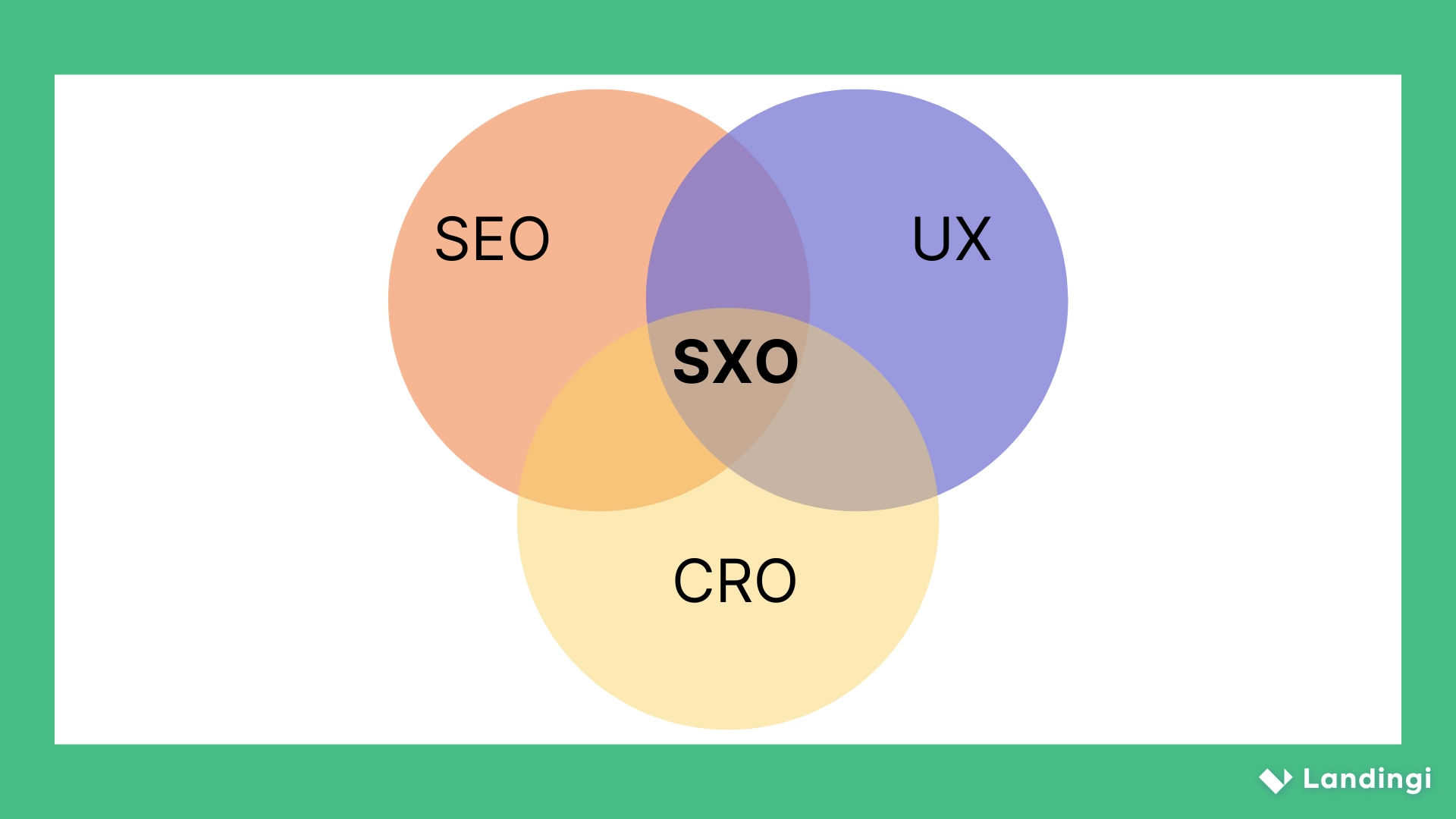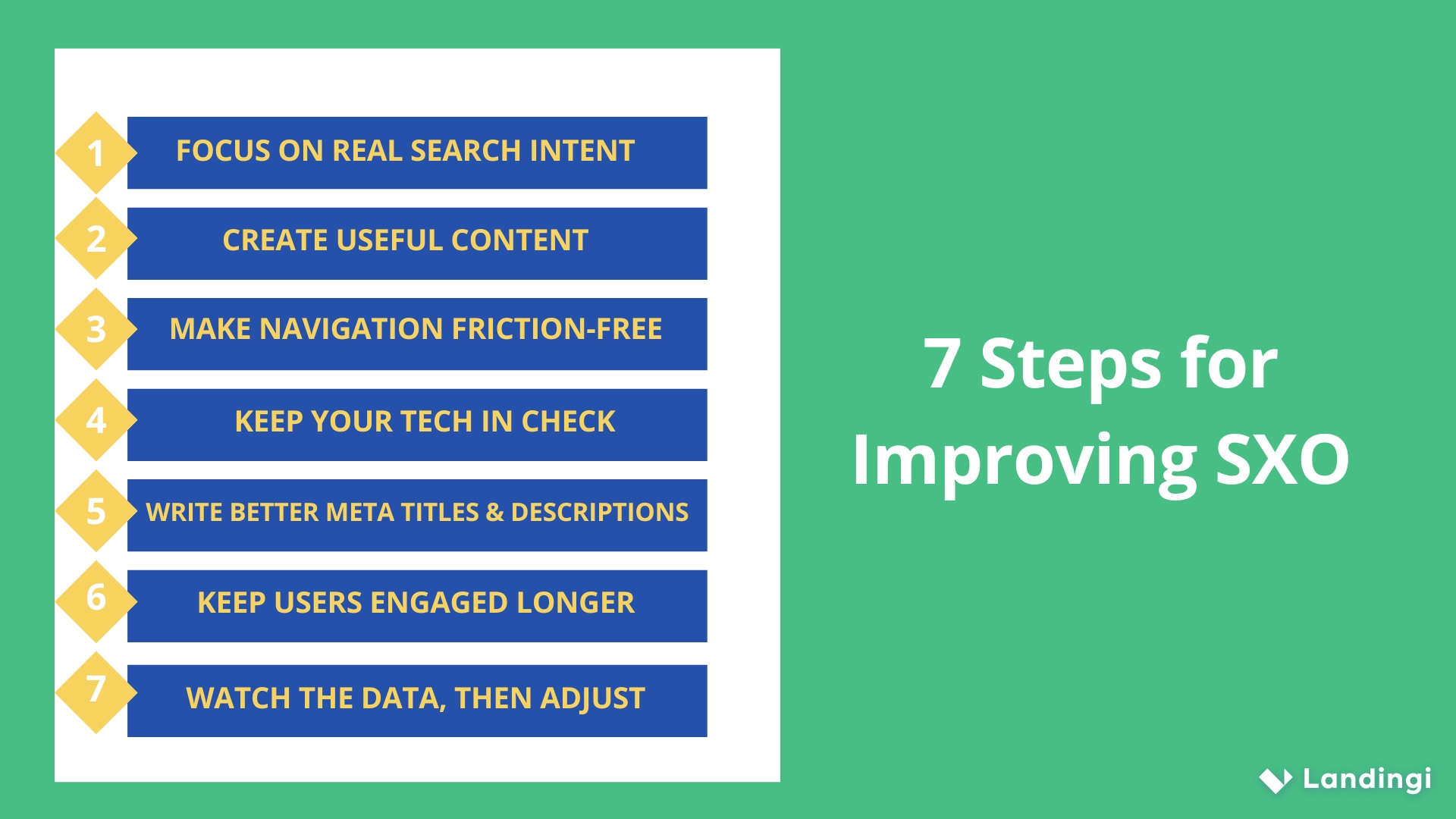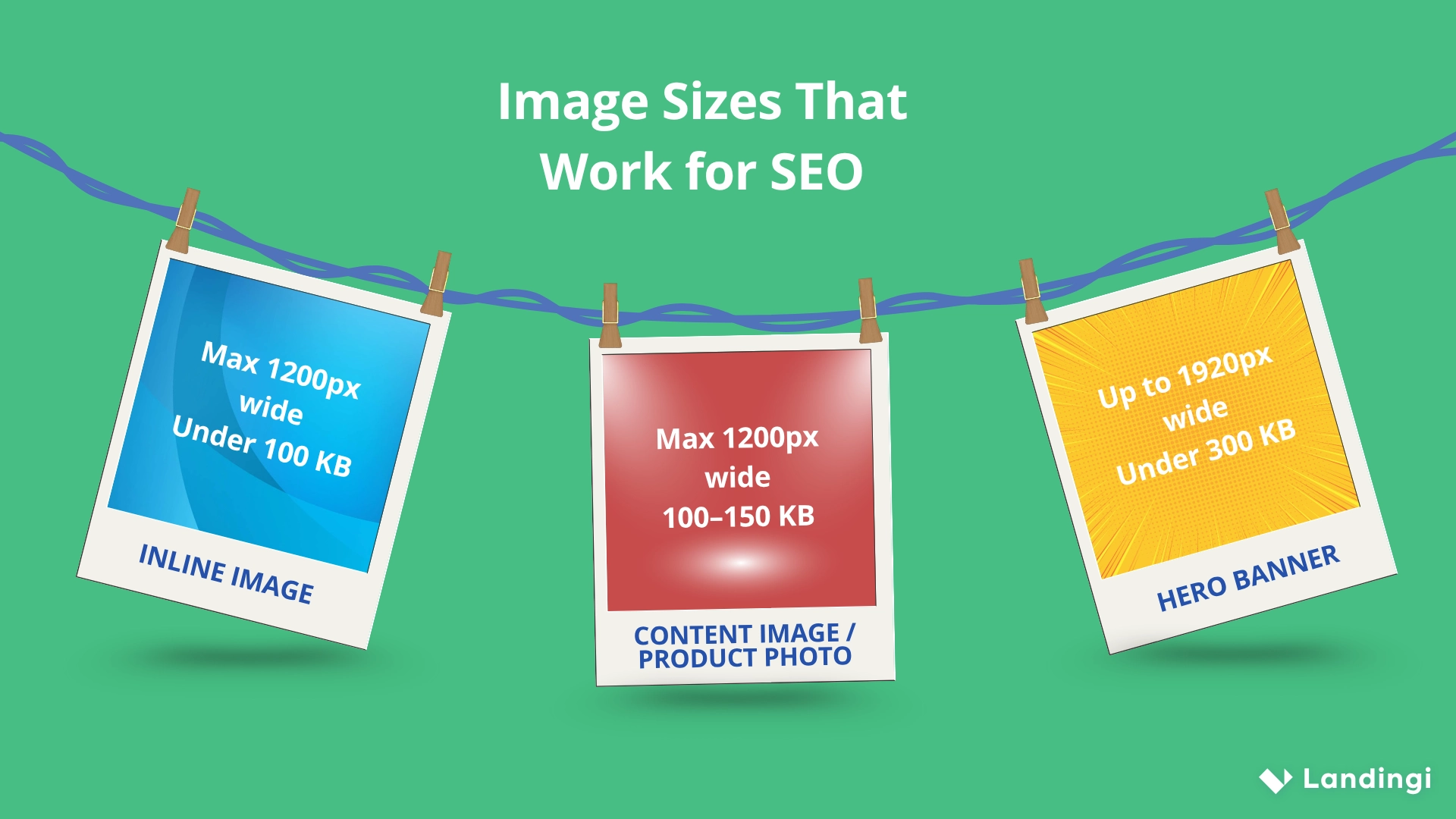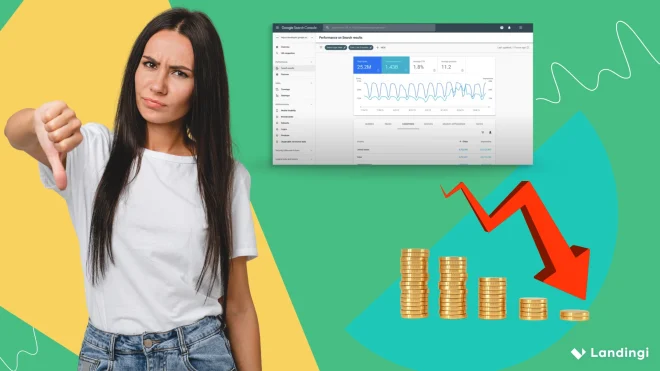Search Experience Optimization (SXO) is the practice of improving both how your website ranks in search engines and how it performs once visitors arrive. It merges SEO, user experience (UX), and conversion optimization (CRO) into one cohesive approach – so you’re not just driving traffic, but turning that traffic into real, measurable outcomes.
At its core, SXO is built on a simple truth: ranking high in search results means little if users leave after five seconds. That’s why SXO focuses on more than visibility. It makes sure your content aligns with search intent, your site loads fast, the layout feels clear, and every call to action has a purpose.
And there’s a lot at stake. About 75% of users never scroll past the first page – so getting seen is just the beginning. That means your site not only has to appear – it has to deliver. Search Experience Optimization helps make that happen by creating a seamless, high-quality search experience that satisfies both Google’s algorithm and the people behind the clicks.

What Is Search Experience Optimization (SXO)?
Search Experience Optimization (SXO) is a digital strategy that combines SEO, UX, and conversion tactics to make websites both easy to find and effective to use. It focuses on bringing the right users to your site—and helping them take action once they arrive.

Now picture this: you Google something, click the top result, and bam—slow load, cluttered layout, irrelevant content. You leave.
That’s exactly what SXO is built to prevent.
SXO aligns your content, design, and performance with how people search, scan, and interact online. It focuses on intent, clarity, speed, and structure, so users can quickly find what they need and know what to do next.
This approach gained importance when search engines started factoring in user behavior. Even with solid keyword research, a well-optimized page that frustrates users won’t stay visible for long.
Today, SXO is a shared space between SEO experts, UX designers, and CRO specialists. It covers everything from technical setup and site architecture to content and calls to action. The goal is clear: guide the user from search to solution with as little friction as possible.
Grab ready-made templates built to match search intent and drive clicks.
What’s The Importance Of SXO?
Search Experience Optimization isimportant because it directly influences how easily users find your site, how effectively they engage with it, and how likely they are to convert or return. It bridges the gap between visibility and usability, making sure your site performs well not only in search engine rankings but also in real user sessions. Without SXO, you may rank, but you won’t retain. You might get clicks, but not conversions.
A site built with SXO in mind loads fast, answers search intent, and guides users without confusion. That leads to higher engagement, lower bounce rates, and better conversion rates – all signs of a site that’s working as it should.
7 Steps For Improving SXO
Improving SXO means optimizing the full search journey—from query to click to conversion. Here’s how to put that into practice:

1. Focus on Real Search Intent
Before you create content, figure out what people are actually looking for. Are they browsing, comparing, or ready to act?
Example: If someone searches “best landing page builder for startups,” they don’t want theory—they want a short list with pros, cons, pricing, and screenshots. Give them that.
2. Create Useful Content
High content quality means solving a problem, clearly and quickly. Write to solve, not to stuff keywords. Make sure your content matches the promise of your title and search snippet.
Example: If your H1 says “How to Increase Conversions,” but your intro dives into general marketing trends, you’ve already lost usability and users. Get to the point fast.
3. Make Navigation Friction-Free
If users can’t find what they’re looking for, they’ll leave. Good SXO includes intuitive design, smart layout, and fast access to key info.
Example: Hiding pricing behind five scrolls is a bad user experience. Make sure critical content is easy to spot and pages are structured around actual user needs.
4. Keep Your Tech in Check
Users won’t wait: a slow, broken, or glitchy site kills trust immediately. The same goes for poor mobile design.
Example: If your mobile load time is over three seconds, you’re losing a chunk of your organic traffic. Test on different devices. Prioritize mobile responsiveness and reduce anything that slows the page—like oversized images, third-party scripts, or autoplay videos.

Pro tip: Use tools like Google PageSpeed Insights to identify what’s dragging your performance down—and fix it.
5. Write Better Meta Titles & Descriptions
Your snippet is the first impression. It should be specific, human-sounding, and match what’s on the page.
Example: Instead of “Landing Page Tips – Company Name,” try “7 Landing Page Tricks That Boosted Our Signups by 40%.” Make people curious enough to click.
6. Keep Users Engaged Longer
Once someone’s on your site, help them keep moving. Internal links, clean layouts, and strong calls to action all matter.
Example: After a post on A/B testing, suggest a downloadable template or another relevant guide. Engagement like that improves SEO metrics and builds loyal customers over time.
7. Watch the Data, Then Adjust
Look at how users behave on your site. What they click, where they drop off, which pages keep them around. Use that data to adjust.
Example: You test two landing pages—one with the CTA near the top, one at the bottom. The top CTA wins. You just improved conversion optimization using real user behavior.
Pro tip: Try Landingi’s EventTracker to see exactly how visitors interact with your pages—clicks, scrolls, hovers, and more. It’s one of the easiest ways to spot friction points and turn them into conversion wins.
Let EventTracker show how deep users go—then design to keep them there.
How To Measure SXO Results?
To measure SXO results accurately, you need to combine traditional SEO metrics with behavioral data that reflects actual user experience. It’s not enough to track keyword rankings or traffic alone – you also have to monitor how users interact with your content, how easily they move through your site, and whether they complete key actions like purchases or sign-ups.
Effective search experience optimization measurement should cover three areas:
- visibility (are people finding you?),
- engagement (are they staying?),
- outcomes (are they converting?).
Start with behavior. If users bounce after a few seconds or barely explore your site, that’s a sign something’s broken—either the content doesn’t match their search intent, or the user journey is too confusing. Metrics like average session duration, bounce rate, and pages per session give clear insight into whether your search experience is working as intended.
Conversions are your next checkpoint. A page that draws traffic but fails to convert may need stronger CTAs, better layout, or more relevant messaging. SXO is all about removing friction—so when conversions go up, you know you’re on the right track.
At the same time, keep an eye on your search performance: impressions, CTRs, and organic traffic growth over time. These numbers show whether your content is visible and appealing within the search engine results pages—still essential for any successful SEO strategy.
And, don’t forget technical signals. Core Web Vitals, site speed, and mobile usability all affect both how users feel on your site and how search engines rank it. Use tools like Google Analytics, PageSpeed Insights, and heatmaps to get a full view—and adjust accordingly.
What Are The Benefits Of SXO?
The benefits of Search Experience Optimization include better search visibility, higher user satisfaction, improved conversion rates, longer time on site, stronger brand trust, and a clear edge over competitors.
First: SXO gets the right people to your site. Not just random clicks, but real users with clear intent. That’s because SXO starts with search behavior—understanding what people are looking for and shaping your content to match. When your page hits the mark, you attract organic traffic that’s far more likely to stick.
Then, they stay. Thanks to user-centric design, fast site speed, and clear structure, users don’t just land and leave—they explore, scroll, and engage. Every second they spend sends a positive signal to search engine algorithms that your page delivers a meaningful search experience.
Next comes action. With friction out of the way – no confusing forms, no buried CTAs – conversion optimization becomes natural. Visitors are guided, not pushed. And when the experience feels smooth, they convert more often.
But SXO doesn’t just improve metrics, it builds memory. People remember sites that feel effortless. They’re more likely to return, recommend, and buy again. That’s how SXO quietly turns first-time visitors into loyal customers.
Behind the scenes, you’re also earning points with Google. SXO checks the boxes that matter: mobile responsiveness, content relevance, technical SEO, and engagement. All of it helps improve search rankings in ways that last.
So yes, SXO increases website traffic, engagement, visibility, and conversions. But more than that—it makes your site feel like it was built for the person behind the query.
Multi-language Pages let you optimize for global search intent—without killing UX.
What Are The Limitations Of SXO?
The limitations of Search Experience Optimization include the speed at which search behavior changes, the complexity of matching user intent, and the technical demands it places on your site. Users shift from typing short keywords to speaking full questions, and what worked yesterday may already feel stale today. Adapting your content creation to keep up with evolving search queries—especially across voice and semantic search—takes constant attention.
There’s also the behind-the-scenes pressure. SXO isn’t just about crafting high quality content; it also relies on near-flawless site speed, seamless mobile responsiveness, and solid technical SEO. Not every team has the setup to maintain that standard across all pages. And in a world where search engine results pages are already crowded with well-optimized content, standing out requires more than best practices—it takes continuous iteration, smart use of engagement metrics, and a lot of patience. SXO is powerful, but it’s not plug-and-play.
Try Landingi for free and craft journeys that match both search and users.
Understand SXO In SEO To Boost Landing Page Traffic
If you’re serious about growing landing page traffic, it’s time to look beyond rankings and start thinking about the experience behind the click. That’s the strength of Search Experience Optimization (SXO)—it connects search engine optimization with real user behavior to help you attract the right target audience and guide them to take action.
SXO makes your content easier to find in search results, but more importantly—it makes it easier to use. When your landing pages are aligned with search intent, load quickly, and deliver valuable content in a clean, intuitive format, users stay, scroll, and convert. It’s how you bridge the gap between content creation and conversion optimization, keeping people engaged throughout the entire user journey.
With platforms like Landingi, it’s easy to put these ideas into practice. From fast-loading templates to tools for conversion optimization, the foundation is already there. Add SXO thinking to the mix, and your landing pages go from visible to effective.






